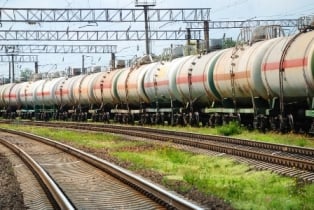The plummeting price of oil has put strain on Canada's oil industry, and economic pressure will be even more intense in three years when the projected oil supply will outstrip transportation capacity.
This means brokers need to act now to ensure those exposures are properly covered.
“The cost of transporting oil by rail car is uneconomical at current oil prices,” says Martin Thompson, senior vice president of commercial insurance and global speciality lines for
RSA Canada. “Yet, due to delays associated with pipeline development, transporting oil by rail is the only scalable option.”
Transporting oil through pipeline is typically less expensive compared to rail. But given the continued reliance and expected increase on rail use, companies may be inclined to cut corners and costs to extend the life of oil tankers and engines.
“On the rail side, we typically see more frequent accidents,” says Thompson. “And when you have more things that can go wrong, it requires greater risk management.”
Due to deteriorating infrastructure, 2014 was the most dangerous year for Canadian railroads, with derailments increasing by 73% from the previous year, according to
Reuters.
“When you look at both methods of transportation, pipelines are generally looked at as being safer,” continues Thompson. “Although there are risks associated with pipelines, technological improvements in recent years help safeguard and manage exposures. Pipeline development has been delayed, however, due to ongoing debates regarding economic and environmental considerations.”
A recent study released by the Fraser Institute showed that pipelines are 4.5 times safer than trains for transporting oil over long distances. Some safety issues include maintenance, speed, the condition of the rail stock, and the tracks themselves. These risks open the door for brokers to discuss risk management strategies when clients are considering how much exposure they are willing to risk.
For one, it is important for brokers to work with organizations experienced in risk management that are knowledgeable in safety issues and exposures associated with rail travel and transport, says Thompson.
“I think from a broker perspective, if you want to look at a Lac Megantic, the issue is that the liability environment surrounding this type of event hasn’t been fully developed,” he says, speaking specifically on properly educating the client on what their true exposures are when it comes to a catastrophic incident.
Brokers should also include a discussion on the amount of limit clients have on their general liability insurance, or the protection they require for environmental issues.
Since the Lac Megantic tragedy in 2013, in which 47 people died after a train broke loose and jumped the tracks to cause an explosion in the city’s downtown, the industry has become more attentive to the potential fallout from a serious disaster.
The wrongful-death settlement from the disaster resulted in $200 million being distributed in settlement funds to the victims’ families and other parties involved in the legal battle, from Montreal Maine and Atlantic Canada Co., its insurance carrier, rail-car manufacturers and some oil producers.
“Until you have an incident like the one in Lac Megantic, you don’t appreciate the magnitude of the issue,” says Thompson. “Once it happens, you start to take a closer look at what clients buy and how they buy it.”
The immediate concern resides in the expected increase in traffic on Canada’s rail system. This increase may place more pressure on existing rail stock operators to work longer hours and maintenance crews to keep those lines open.
“There will clearly be a higher volume of oil transported by rail over the next several years, which requires a focus on discouraging mismanagement,” says Thompson. “That’s where the insurance industry can help: risk management.”
While brokers may feel they do not have all the knowledge or tools available to speak confidently on specific exposures faced by clients in the oil transportation industry, they can tap into the underwriting and analytical expertise held by insurance carriers to make a convincing case for better coverage.
“At the end of the day, insurers will respond as customer needs develop – and this is why insurers should offer their expertise when it comes time to help customers identify their needs,” Thomspon says.
“It’s critical to us that we foster a strong tripartite relationship because by working together – insurance carrier, broker and client – we can develop the right solution for our clients and customers.”
Want to keep the conversation going? Visit rsabroker.ca to learn more.


